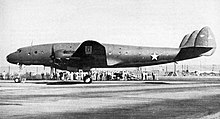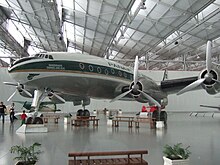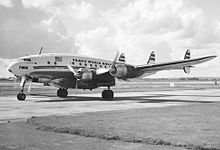Lockheed Constellation
The Constellation series was the first civil airliner family to enter widespread use equipped with a pressurized cabin, enabling it to fly well above most bad weather, thus significantly improving the general safety and ease of commercial passenger air travel.
In total, 856 were produced between 1943 and 1958 at Lockheed's plant in Burbank, California, and used as both a civil airliner and as a military and civilian cargo transport.
TWA's requirements led to the L-049 Constellation, designed by Lockheed engineers, including Kelly Johnson and Hall Hibbard.
The first prototype (civil registration NX25600) flew on January 9, 1943, a short ferry hop from Burbank to Muroc Field for testing.
[2] Edmund T. "Eddie" Allen, on loan from Boeing, flew left seat, with Lockheed's own Milo Burcham as copilot.
[9] In total, 22 C-69s were built before the end of hostilities, but seven of these never entered military service, as they were converted to civilian L-049s on the assembly line.
[citation needed] As the first pressurized airliner in widespread use, the Constellation helped establish affordable and comfortable air travel.
[11] Jet airliners such as the de Havilland Comet, Boeing 707, Douglas DC-8, Convair 880, and Sud Aviation Caravelle rendered the Constellation obsolete.
Constellations carried freight in later years, and were used on backup sections of Eastern Airlines' shuttle service between New York, Washington, and Boston until 1968.
[13] One of the reasons for the elegance of the aircraft was the dolphin-shaped fuselage, a continuously variable profile with no two bulkheads the same shape and a skin formed into compound curves, which was expensive to build.
[8] Military versions included the C-69 and C-121 for the Army Air Forces/Air Force and the R7O R7V-1 (L-1049B) EC-121 WV-1 (L-749A) WV-2 (L-1049B) (widely known as the Willie Victor) and many variant EC-121 designations for the Navy.
[16][17] After TWA's initial order was filled following World War II, customers rapidly accumulated, with over 800 aircraft built.
In military service, the U.S. Navy and Air Force operated the EC-121 Warning Star variant until 1978, nearly 40 years after work on the L-049 began.


















